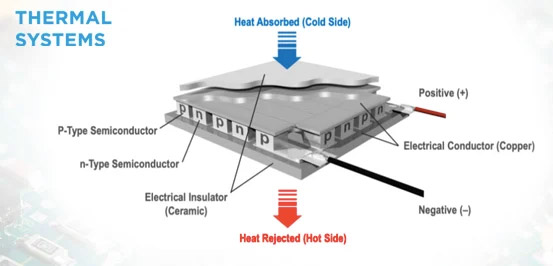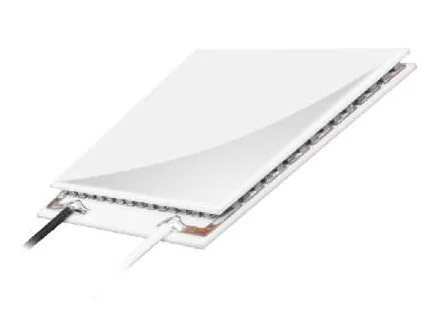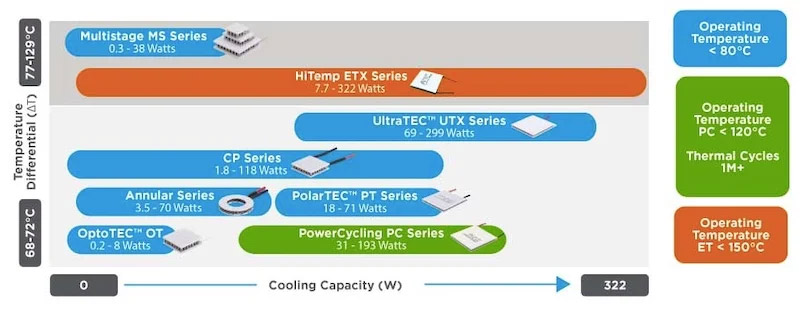Thermoelectric coolers are attracting attention for replacing old cooling and refrigeration devices. TECs provide design engineers with a wide range of cooling capacities, temperature differentials, form factors, finishing options, and thermal cycling capabilities—all while curbing the release of harmful chlorofluorocarbons (CFCs) into the atmosphere.
How exactly do these devices operate? And what are some use cases in which they are cropping up?
What are Thermoelectric Coolers?
A thermoelectric cooler (TEC) is a solid-state device used for precise temperature control. Not only can it cool electronics to nearly 70°C but it can also be used as a heat pump. TECs operate by the Peltier effect, the state of temperatures changing at two electrical junctions due to current flow.
By integrating thermoelectric coolers into systems, design engineers are able to heat, cool, and even control temperatures in inclement weather while depleting greenhouse gas emissions.

Thermoelectric coolers offer instantaneous temperature change capabilities to allow for heating, cooling, and thermal management of the integrated system. Image used courtesy of Laird Thermal Systems
At the circuit level of TECs, a DC voltage applied to one of the junctions will initiate a flow of current, leaving heat in one conductor as it travels to the other junction. Once the heat has dissipated to the next junction, the cooling begins in the initial semiconductor material and the process continues for an array of junctions in series.
The TEC cooling is proportional to the applied current and the heating is proportional to the square of the current. A basic TEC consists of a conventional bridge amplifier, transducer bridge, an active filter, a thermistor (with resistance that varies with temperature), and transistors.
Applications for Thermoelectric Coolers
TECs provide versatile solid-state cooling or heating control at low operating requirements and can be integrated into a system underwater, in space, or in other harsh environments.
As an example of a recent TEC development, Laird Thermal Systems recently announced thermoelectric coolers to stabilize the temperature in outdoor security cameras, especially during inclement weather.

TECs operate according to the Peltier effect. Image used courtesy of II-VI Incorporated
Laird claims that the new Hi-Temp ETX series is a useful option for outdoor security systems since it can withstand 150°C. It is also said to boost cooling capacity by 10% and integrate easily into unique footprint requirements.
For industrial applications such as laser projectors and medical diagnostic systems, Laird Thermal Systems’ UltraTEC UTX series can also be used in applications that require heat pumping of up to 296 W.
Although human skin is a poor conductor, TECs operate under thermally-resistive environments. TECs can be found in wearables as a way to cool human skin up to 8.2°C. Modern applications for TECs can be found in car seat cushions, mattresses, and thermal pads built for bodily contact.
Design Challenges Prompt More Research
TECs provide systems with a lightweight, noiseless, cost-effective heat management solution geared toward electronic packages, microprocessors, precision devices, and laser equipment.
However, there are some design challenges that linger when utilizing TECs. TECs may not be able to achieve the equivalent cooling efficiency of traditional refrigeration, a factor that holds them back from extensive use.

Laird Thermal Systems' TECs are designed to accommodate systems that require operating temperatures of less than 80°C to 150°C. Image used courtesy of Laird Thermal Systems
Another challenge comes with the evolution of technology. With the fast-paced growth of modern electronics, more elegant multi-level TECs will be needed to function in multi-stage designs.
Currently, the TEC market is saturated with solutions similar to Lairds’, which are able to achieve complex design specifications. However, designers require more time and research on applying parallel TECs along with external components to compensate for issues of energy conversion and heat dissipation.
Still, because they do not produce refrigerant emissions, TECs are a sound design option if the goal is environmental friendliness. In addition, these devices offer low maintenance, longer lifespan, controllability, and thermal performance improvement.
